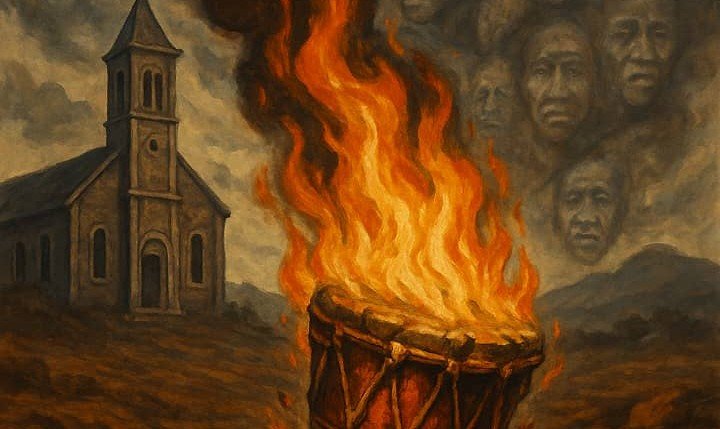By Emmanuel Mihiingo Kaija
I. Under the Skin of Silence: A Theft Deeper than Iron and Ivory.
Beneath the ancestral canopy of stars, where rivers hum the names of forgotten monarchs and the winds carry the prayers of the living dead, there lies a wound buried in the very marrow of Africa’s spirit—a wound unhealed, unspoken in the corridors of power, yet never forgotten in the marrow of our bones. This is not the ache of lost gold or the bitterness of stolen territory alone. No, this is a deeper, more intimate desecration—the theft of breath, of soul, of sanctified matter. It is the pillaging of altars that once sang with incense and oracles, the silencing of drums that once beat the rhythm of revelation, the exile of sacred objects that were not merely objects, but incarnations of divine presence. What empire took was not decoration—it was ontology.
Let no one call this “art theft” with the sterile language of auction houses. These were not commodities; they were convocation. Each Nkisi was a covenant. Each carved ancestral stool, a throne of intercession. The Tabot was not a symbol—it was the ark itself. When these were stolen, it was not history alone that was violated; it was liturgy, cosmology, identity. What was severed was the umbilical cord between spirit and soil.
As Dr. Bénédicte Savoy writes in Africa’s Struggle for Its Art, “What was taken is not just physical—it is ontological. They looted memory.” The Benin Bronzes were not cast in vanity, but in sacred vocation. Each plaque was a theological document hammered in bronze, chronicling a kingdom’s relationship with time, transcendence, and divine order. Their theft in 1897 by the British—who called it a “punitive expedition,” as if justice could ride on cannon fire—was nothing less than a cultural crucifixion.
Today, more than 90% of Africa’s tangible cultural heritage resides in institutions outside the continent. From the Musée du quai Branly in Paris to the British Museum in London, sacred African artifacts sit behind glass, severed from the rituals that once gave them breath. The Open Restitution Africa initiative confirms what our elders have always whispered: that our gods were taken, and our memory imprisoned. “Can the drum speak in exile? Can the spirit of the rain be bottled and renamed?” — Ewe saying
The French call these holdings collections, but they are more accurately mausoleums—repositories of sacred bodies torn from their temples. And with each display comes the quiet colonization of gaze, the rebranding of sacred presence into primitive artifact. The camera flashes, but the ancestors weep.
We must ask: what does it mean for a people to lose their gods and have them renamed “primitive art”? What is the cost of severing spirit from soil, ritual from rhythm, tabot from temple? Theologians speak of incarnation—of God made flesh—but what of the gods made bronze, made drum, made mask, whose very materiality was a theology? They were not metaphors. They were breath itself. “How shall we sing the Lord’s song in a strange land?” — Psalm 137:4
That ancient Hebrew lament now lives in African tongues. For to have one’s sacred memory displayed in foreign halls is to be told, again and again: your gods are guests here, your identity a curiosity, your altar a relic. We were never invited to curate these collections, and yet the spirits still call our names through the glass. And so, this is not merely about objects. This is about ontology. This is not merely history. It is haunting. This is not merely the past. It is prophecy unfulfilled. “When the shrine is empty, the spirits wander. When the spirits wander, a people forget how to walk.” — Bamileke proverb
II. Liturgy of Loss: A Timeline of Cultural Exile
Let us approach these dates not as historians alone, but as mourners, as prophets, as archivists of grief. These are not footnotes to empire—they are funeral hymns. Every year marks a wound. Every artifact taken is a body buried without ritual. Every museum tag is a stolen psalm. This is not history—it is liturgy. A liturgy of loss.
1897: The Rape of Benin — Theology Torn from Bronze
The British, in their so-called “Punitive Expedition,” descended upon the Kingdom of Benin like locusts sent by empire. Over 4,000 sacred bronzes, carved ivory tusks, and altar pieces were looted. The Oba was exiled. Royal altars were toppled. Priesthoods were shattered. What they took were not “royal trinkets” but the entire liturgical calendar of a civilization. The bronzes were records of kingship, court rituals, divine authority. To steal them was to erase the scriptural continuity of a people’s divine mandate.“The python never forgets the path to the shrine.” — Urhobo proverb. Yet even the python returned to find the shrine in chains.
1868–1935: Ethiopia’s Tabots — Arks in Exile
The Tabots, replicas of the Ark of the Covenant, sacred to Ethiopian Orthodox Christianity, were looted by Italian soldiers and missionaries during various incursions. More than 40 Tabots remain hidden in churches, private collections, and museums across Europe. These were not ritual accessories—they were the heart of processions, the soul of the liturgy. They were never meant to be seen, only venerated. To expose them to the foreign gaze is to defile a covenant. Imagine the Eucharist displayed as artifact. That is what they did.
1884–1885: The Berlin Conference — Communion of Colonizers
Fourteen European powers gathered not to worship but to dissect, divide, and devour. Not one African voice was present. Borders were drawn with steel rulers across sacred rivers, kinship lines, and cosmological spaces. Entire spiritual geographies were shattered. What followed was not merely political colonization—it was cultural dismemberment. Sacred groves became mines. Shrines became dust. Priests became prisoners. Rituals were criminalized.“When elders are not consulted, children eat stones thinking they are fruit.” — Kikuyu proverb
1900–1960: Missionary Campaigns and the Incineration of Memory
Across Uganda, Nigeria, Congo, Ghana, Zimbabwe—Christian missionaries, often allied with colonial administrations, orchestrated large-scale burnings of indigenous ritual objects. Drums, masks, sacred stools, and totems were cast into flames under the guise of spiritual purification. But what was scorched was not evil—it was cultural theology. What was destroyed was not devilry but divine dialects. These were not conversions. These were cremations of cosmology.
2021: Macron Returns 26 Objects — A Drop in the Desert
France’s President Emmanuel Macron, in a gesture both historic and hollow, returned 26 looted objects to Benin. Yet France still holds over 90,000 African artifacts. A symbolic drop, not a flood of repentance. While media praised the return, no reparations were made, no systemic change enacted. It was a performance in the theatre of diplomacy—an apology scripted in the language of empire.
Present Day: The Ongoing Exile
As of 2025, reports from Open Restitution Africa show that less than 2% of African nations’ sacred heritage held abroad has been repatriated. Most of what was stolen remains behind thick security glass and colonial silence. Some items are auctioned. Others are forgotten in museum basements, labeled “unknown origin,” as if amnesia were an act of neutrality. “When a drum is silent, the village begins to forget the language of rain.” — Luba proverb
And what are museums today if not temples of curated amnesia? We call them collections, but what they hold are the dislocated gods of nations. To walk into a European museum’s Africa section is to enter a tomb where spirits are misnamed and voices muted. The objects do not speak—they cry. These are not artifacts. They are exiles. These are not exhibitions. They are wounds under fluorescent light. This is not memory. It is mourning in glass.
III. A Gospel Violated: Of Missionaries, Memory, and Muzzled Women.
Where were the missionaries when memory was being stolen?
The question quivers still, unanswered in the courtyards of mission schools, unspoken in the dusty archives of colonial churches. It rings through Africa’s sanctuaries like a broken shofar—once meant to call the people to God, now echoing over ruins and relics renamed. For the Gospel that proclaimed resurrection too often arrived arm in arm with conquest. With one hand, they offered Scripture; with the other, they held torches to ancestral shrines.In the name of salvation, entire cosmologies were buried alive.
Missionaries, many earnest and sincere, believed they were bringing light. But the light was often filtered through the lenses of empire. In Uganda, Nigeria, Congo, and Zimbabwe, colonial priests and evangelists did not merely preach—they confiscated masks, demonized dances, desecrated ritual spaces. Shrines were razed. Drums were silenced. Names were erased from the tongues of children in mission schools, replaced by foreign saints. Christianity, instead of incarnation, became colonization. “When the stranger enters with honeyed words and fire behind his back, the compound must beware.” — Akan proverb
Theological scholar Jesse N.K. Mugambi, in Christianity and African Culture, warns that colonial mission blurred the line between evangelism and erasure. What should have been the Gospel incarnated into culture became the Gospel entangled with oppression. In place of Christ walking in the cool of the African evening, we received Christ locked in European vestments, unable to speak our names. Too many missionaries came not to dwell, but to dominate. The consequence? A fracture not only between Africa and her sacred objects, but between Africa and the Gospel itself. “Can the Gospel be Good News if it silences the memory of a people?” Can it still be called redemption if it arrives riding the coattails of those who plunder? And what of the women?
In many African communities, women were the priestesses, the diviners, the anointed singers of the sacred. They carried the gods on their backs and in their wombs. They were the memory-keepers, the ritual midwives, the elders who taught children how to speak to the land. Yet in the mission’s theology, their power was demonized. Their sacred roles were erased or labeled witchcraft. The tambourine became “unclean.” The ancestral song became “pagan.” The matriarch of the shrine became a danger to be exorcised. “When the river forgets its source, even the fish begin to die.” — Tswana proverb
To silence these women was not only misogyny—it was a theological calamity. A spiritual deforestation. What was lost was not merely a few rituals or objects. What was lost was a worldview, a rhythm of existence where the sacred pulsed in daily life, where women’s words were scripture and movement was liturgy. The desecration of female spiritual leadership has left a haunting absence—a silence in the choir, a missing voice in the communion of saints.
Today, many churches remain mute on the matter of restitution. Few issue statements. Fewer take action. The looted sacred items remain abroad, yet the church sings on, as if nothing was taken, as if no altar was toppled, no memory exiled. The silence of the church is an indictment. To preach Christ and remain quiet about memory theft is to offer healing with a hand still holding the knife. If Christ came to restore all things, then the Gospel must include the restoration of memory. It must include confession. It must include reparative justice. “A broken calabash may still hold rain, if mended with truth.” — Yoruba proverb
IV. Theology in Exile: What Happens When Our Gods Are Gone.
Theology is not written in ink alone. In Africa, theology was carved, chanted, danced, brewed, and breathed. The sacred did not reside only in scrolls—it flowed in calabashes, thundered in drums, shimmered in masks. A staff was not a symbol; it was spirit solidified. A stool was not mere furniture; it was an ancestor’s throne. A gourd was not a container; it was covenant. When these objects were taken, theology did not merely suffer abstraction—it experienced exile. And in exile, the voice of the divine began to stutter.
For African cosmologies have long known what many Western theologians forgot: that matter is not neutral. It carries presence. A carved figure, blessed through ritual, becomes a vessel of encounter. A flute, once played to summon rain, becomes an instrument of prophecy. These are not quaint customs; they are sacraments in motion. But when these objects were stolen, and relocated into sterile glass boxes in Europe, their breath was severed. “A flute behind glass cannot summon the rain.” — Lozi proverb
The museum became the mausoleum of our gods. Some theologians now urge us to “move on,” to embrace a spirituality unmoored from material culture, to forgive the past and walk forward into some sanitized future. But this is not reconciliation—it is rupture. As Kwame Bediako rightly insisted, “African theology is not complete until it can speak from within its own memory.” Yet memory is not abstract. It lives in wood, iron, stone, and smoke. It lives in the drum that knows the rhythm of the ancestors. What happens to a people when their theology is caged in another continent?
We begin to speak in borrowed metaphors. We forget the original grammar of praise. We search for the divine in temples shaped by someone else’s story. And so, instead of reconstructing altars, we build replicas. Instead of listening for our ancestors, we cite foreign thinkers. Instead of inculturated theology, we receive franchised faith. “The ancestors do not die when their names are spoken. They die when we cannot find their altars.” — Shona saying
In Revelation 6, the martyrs cry, “How long, O Lord?” And Isaiah 58 demands a fast that looses the chains of injustice. These are not passive texts. They call us to repair the breach—and the breach is memory, fractured by empire. To retrieve our sacred objects is not nostalgia. It is eschatological fidelity. It is the resurrection of the communal body. It is restoration of theological rhythm. The church that ignores this work does not only ignore Africa—it ignores the Spirit. For even the Holy Spirit descended not into abstraction, but into upper rooms, flames, tongues, and trembling bodies. “A mask without its dance is like a word without breath.” — Ga proverb
We must therefore return to the theology of the drum, the liturgy of the calabash, the catechism of the carved stool. We must rescue not just objects, but our sacred imagination. We must reweave theology not merely with verses, but with vessels—tabots and nkisis, gourds and altars—where the divine once dwelled not as theory, but as thunder. Until our gods return, we must be bold enough to say: Theology itself is in exile.
V. Return as Reparation: More Than Just Sending Things Back
To return a stolen sacred object is not to mail a package—it is to bury a corpse that was left above ground. It is to enter the temple barefoot, trembling. It is to finally call theft by its proper name and to perform repentance not with words, but with weight. For in Africa, apology is not a speech—it is a ritual. It must be enacted. And restitution, if it is to be sacred, must follow suit. The return of our gods must not be an event—it must be a reckoning.
In recent years, a few institutions have made gestures: Germany, in 2022, returned several Benin Bronzes. France, as mentioned, gave back 26 treasures to Benin. But these moments, though welcome, are not yet justice. They are fragments of a shattered jar—symbolic, cautious, often curated for public relations more than for the ancestors.
As Felwine Sarr and Bénédicte Savoy argued in their groundbreaking 2018 report, restitution must not be conditional, nor should it be delayed by legal debates crafted in colonial ink. These sacred items were not taken with permission—why should their return require paperwork? “The hand that steals the drum should not complain of the sound it makes.” — Ibibio proverb. True reparation involves more than the object. It requires reweaving the world around it. The altars that once held these items have crumbled. The rituals have been interrupted for generations. The storytellers were shamed into silence. Therefore, restitution must also mean:
1.Investing in cultural infrastructure: Museums, archives, memory sanctuaries built and curated by African hands.
2.Educating the next generation: School curricula that restore the centrality of ancestral theology.
3.Training indigenous curators, archivists, and theologians: So that memory returns not just as spectacle, but as knowledge.
4.Funding community-led reconsecration rituals: Because what was sacred must not be returned without ceremony.
5.Legal reforms and reparations funding: To give nations the right to pursue stolen memory without begging.
And what of the church? If it was complicit in theft, it must now become a vessel for return. We call upon global and African churches to fund Memory Justice Commissions. To allocate reparations budgets. To host public rituals of lament. To admit their complicity in the desecration of sacred spaces. For the Gospel that ignores the theft of godhood is a Gospel that cannot heal. “The child whose mother is silent at market will be priced by strangers.” — Igbo proverb
Where are the African governments in this? Too many have settled for exhibitions in Europe, hosting events where our stolen sacreds are paraded like celebrities. But dignity cannot be borrowed. It must be reclaimed. Our gods were never meant to be on tour. We must reject the idea that repatriation is charity. It is not generosity—it is justice. And if justice is to roll down like waters, then those waters must flow over embassies, churches, university departments, and museum steps. They must flood the silence.For as long as the bronzes remain locked away, the bones of our theology rattle in exile. And until the gourd is returned to the fire, the ancestors remain thirsty. “When the pot is cracked, it cannot carry the ancestor’s drink.” — Banyarwanda saying
VI. We Will Tell Our Stories in Stone and Sky
Even if the tabots remain hidden in European churches, even if the Benin Bronzes are locked in climate-controlled vaults, even if the nkisi lie mislabeled in the bowels of foreign museums—we shall not forget.For memory, like water, carves new channels when the riverbed is blocked. We will tell our stories in the murals painted on cracked city walls. We will summon our gods in songs sung beneath trees too sacred to name. We will whisper prayers in the kitchens of grandmothers, where every spice tells a genealogy. We will pass down the story of the sacred theft to our children, not as grievance—but as gospel. Not as bitterness—but as birthright. “Even the leopard, once caged, still remembers how to run.” — Kiswahili proverb
In the sacred forests of Ghana, in the caves of Dogon elders, in the deep soil of Kongo cosmology, memory still breathes. It may be wounded, but it is not dead. We will rebuild shrines—not to worship bronze or wood, but to remember what they meant: connection, covenant, presence. The bronze is not the god. The bronze was the breath of the god. And if the breath was stolen, we now exhale anew. We are not begging for return. We are preparing for resurrection.
Let the museums keep their glass. Let the universities keep their theories. Let the auction houses hide their shame. We are not waiting—we are remembering. And in that act of remembering, we create anew. Our poets will write new liturgies. Our theologians will preach sermons that rise from soil, not just scripture. Our artists will chisel the faces of forgotten gods into stone that no empire can erase. Our children will know that their ancestors danced with the divine, and that their bodies are altars. “The rain does not forget the sky, even when caught in a jar.” — Luo proverb
We are gathering fragments, not to mourn them, but to multiply them. Just as the early church met in catacombs, so shall we meet in classrooms, in ceremonies, in sacred silence. We shall rebuild what they tried to erase. And one day, the museums will tremble. Not from riots. Not from lawsuits. But from silence. For when African children no longer visit their stolen gods, when they walk past the Africa section of European museums unmoved, uncurious, unbowed—then the curators will know: memory has returned home.
“The tree does not ask permission before growing toward the sun.” — Banyoro proverb. And until every god returns, until every altar is re-anointed, we declare: We are the altar. We are the tabot in motion, the sacred vessel wandering, the theology walking in sandals across scorched earth. Our bodies carry memory. Our bones remember rhythm. Our breath is liturgy. Our lives are gospel. Let the world take note: the gods were never dead.
They were only waiting for us to remember.
Emmanuel Mihiingo Kaija
Independent Researcher
Emkaijawrites@gmail.com








